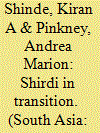|
|
|
Sort Order |
|
|
|
Items / Page
|
|
|
|
|
|
|
| Srl | Item |
| 1 |
ID:
184147


|
|
|
|
|
| Summary/Abstract |
This article explores how local Chinese authorities employed various strategies to promote the Patriarch of Sanping’s cult in post-Mao China from 1979 to 2015. It argues that the cult of the Patriarch of Sanping became an invented tradition for expanded religious tourism in Pinghe County in Zhangzhou, Fujian Province. Local state agents employed various placemaking strategies to promote Sanping Monastery and endorse the deity’s efficacy, creating an opportunity for resources to be channeled from other parts of China, Taiwan, and overseas Chinese communities to develop Pinghe County. This study shows that, on the one hand, local state agents have propagated miracle tales to entice devotees to visit and make donations to this monastery while, on the other hand, they have courted scholars, journalists, and tour guides to generate attention and interest in the cult. Overall, this article demonstrates how local government placemaking and marketing strategies have contributed to the transformation of a Buddhist master from a local deity to a popular god in contemporary China.
|
|
|
|
|
|
|
|
|
|
|
|
|
|
|
|
| 2 |
ID:
126168


|
|
|
|
|
| Publication |
2013.
|
| Summary/Abstract |
The transformation of 'guru devotion' centres as pilgrimage destinations is a growing phenomenon in contemporary Indian religious practice. In this study, we consider how the town of Shirdi, in Maharashtra, is undergoing rapid transformation as it emerges as a religious tourism destination at the epicentre of the global Sai Baba movement. Since the 1918 death of Sai Baba, a Maharashtrian saint, Shirdi has grown from a rural hamlet to a bustling town with some thirty thousand permanent residents and an estimated annual influx of eight million short-term visitors. Focusing on Shirdi as a centre of guru devotion, we examine how socio-spatial transformations have created a new mosaic of regional pluralism at the site. While the coexistence of different communities is one of the hallmarks of religious pluralism in India, we argue that the complementary compartmentalisation of co-religionists hailing from different regions is a significant outcome of rapid urbanisation at pilgrimage sites, particularly those associated with guru devotion.
|
|
|
|
|
|
|
|
|
|
|
|
|
|
|
|
| 3 |
ID:
190087


|
|
|
|
|
| Summary/Abstract |
In Shiite culture, pilgrimage and shrines of Imams and Imams are very important. Shrines in Islamic Iranian cities have a special place in terms of belief, culture, pilgrimage, tourism, and urban. Some of these shrines, such as the shrines of Mashhad and Qom, have pilgrims from different cities and countries. Pilgrimage tourism in Shiite cities has various dimensions and needs that lack of attention to them creates various problems. Therefore, the purpose of this article is to explain the dimensions and strategies for the development of pilgrimage tourism in the pilgrimage cities of Iran, which has been done by researching the content of the text with a qualitative and interdisciplinary approach. The results indicate that shrines have different typologies such as the tombs of imams, religious leaders, and shrines. Pilgrimage tourism in the pilgrimage cities of Iran has physical, functional, access and movement spatial components, urban, social, cultural, and environmental landscape, which requires comprehensive planning and design and a special perspective for the development of the shrine in all dimensions. It is also necessary to pay attention to local conditions and cultural and social contexts, rituals and traditions of pilgrimage, the needs of pilgrims, functional infrastructure, tourism, and services.
|
|
|
|
|
|
|
|
|
|
|
|
|
|
|
|
|
|
|
|
|